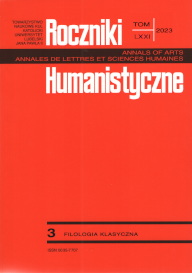„Meus, velis, nolis, meus es”. Kuszenie starotestamentowego Józefa w szesnastowiecznych dramatach łacińskich
“Meus, Velis, Nolis, Meus Es”: The Temptation of the Old Testament Joseph in Sixteenth-Century Latin Dramas
Author(s): Izabela BogumiłSubject(s): Language and Literature Studies, Studies of Literature, Other Language Literature, Philology
Published by: Towarzystwo Naukowe KUL & Katolicki Uniwersytet Lubelski Jana Pawła II
Keywords: Neo-Latin drama; drama of the sixteenth-century; biblical motif of Joseph’s temptation; Cornelius Crocus; Andreas Diether; Georgius Macropedius; Martinus Balticus; Egidius Hunnius; Simon Simonides; Jo
Summary/Abstract: Among the episodes in Joseph’s biblical life, the most inspiring for painters and poets was the temptation of the young Israelite by Potiphar’s wife. This article attempts to show how this motif was fulfilled in the plays of sixteenth-century Neo-Latin playwrights: Cornelius Crocus, Andreas Diether, Georgius Macropedius, Martinus Balticus, Egidius Hunnius, and the Polish poet Szymon Szymonowic (Simon Simonides). The New Latin authors show great ingenuity in this matter: they often build several scenes with the motif of temptation, which is played out directly in front of the viewer’s eyes, recalled as part of a character’s statements or else meticulously reported, as in Szymonowic by a nanny, a witness to the event. There is no doubt that some elements such as the motif of Joseph’s beauty or, for example, moralizing tendencies are repeated in these plays. Their authors rely on a common source – the biblical Book of Genesis – and they also imitate each other’s works.
Journal: Roczniki Humanistyczne
- Issue Year: 71/2023
- Issue No: 3
- Page Range: 7-26
- Page Count: 20
- Language: Polish

